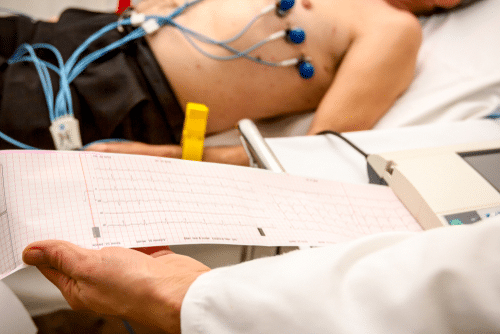Electrocardiogram
An electrocardiogram — abbreviated as EKG or ECG — is a painless, test that measures the electrical activity of the heartbeat. With each beat, an electrical impulse, or “wave”, travels through the heart. This wave causes the muscle to squeeze and pump blood from the heart. A normal heartbeat on an ECG will show the timing of the top and lower chambers.

The right and left atria, or upper chambers, make the first wave called a “P wave”. The “P wave” follows a flat line when the electrical impulse goes to the bottom chambers. The right and left bottom chambers, or ventricles, make the next wave called a “QRS complex”. The final wave, or “T wave”, represents electrical recovery or return to a resting state for the ventricles.
The results from an electrocardiogram will show your physician and provider:
- Irregularities in your heart rhythm (arrhythmias).
- If blocked or narrowed arteries in your heart (coronary artery disease) are causing chest pain or a heart attack.
- Structural problems with your heart’s chambers.
- A previous heart attack.
- How well certain ongoing heart disease treatments, such as a pacemaker, are working.
Why is an electrocardiogram done?
An ECG provides two major kinds of information. First, by measuring time intervals on the ECG, a doctor can determine how long the electrical wave takes to pass through the heart. Finding out how long a wave takes to travel from one part of the heart to the next shows if the electrical activity is normal or slow, fast or irregular. Second, by measuring the amount of electrical activity passing through the heart muscle, a cardiologist may be able to find out if parts of the heart are too large or are overworked.
Electrocardiograms at San Tan Cardiovascular Center
We perform annual EKG’s on our patients as part of your routine healthcare.
How do I get started?
Contact San Tan Cardiovascular Center today to make an appointment with one of our healthcare providers.
At this appointment:
- we will review your medical history, discuss your symptoms and perform a non-invasive, diagnostic test to further determine your medical condition,
- any pertinent testing that needs to be done beforehand will also be ordered at this time.
Our billing department will then contact your health insurance company to obtain prior authorization. Upon receiving insurance authorization, the test will be scheduled.